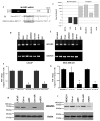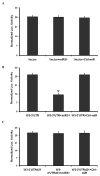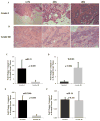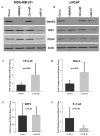WAVE3, an actin remodeling protein, is regulated by the metastasis suppressor microRNA, miR-31, during the invasion-metastasis cascade
- PMID: 21105030
- PMCID: PMC3081370
- DOI: 10.1002/ijc.25793
WAVE3, an actin remodeling protein, is regulated by the metastasis suppressor microRNA, miR-31, during the invasion-metastasis cascade
Abstract
WAVE3, an actin cytoskeleton remodeling protein, is highly expressed in advanced stages of breast cancer and influences tumor cell invasion. Loss of miR-31 has been associated with cancer progression and metastasis. Here, we show that the activity of WAVE3 to promote cancer cell invasion is regulated by miR-31. An inverse correlation was demonstrated between expression levels of WAVE3 and miR-31 in invasive versus noninvasive breast cancer cell lines. miR-31 directly targeted the 3'-UTR of the WAVE3 mRNA and inhibited its expression in the invasive cancer cells, i.e., miR-31-mediated down-regulation of WAVE3 resulted in a significant reduction in the invasive phenotype of cancer cells. This relationship was specific to the loss of WAVE3 expression because re-expression of a miR-31-resistant form of WAVE3 reversed miR-31-mediated inhibition of cancer cell invasion. Furthermore, expression of miR-31 correlates inversely with breast cancer progression in humans, where an increase in expression of miR-31 target genes was observed as the tumors progressed to more aggressive forms. In conclusion, a novel mechanism for the regulation of WAVE3 expression in cancer cells has been identified, which controls the invasive properties of cancer cells. The study also identifies a critical role for WAVE3, downstream of miR-31, in the invasion-metastasis cascade.
Copyright © 2010 UICC.
Figures







References
-
- Cory GO, Ridley AJ. Cell motility: braking WAVEs. Nature. 2002 Aug 15;418(6899):732–3. - PubMed
-
- Sossey-Alaoui K, Li X, Ranalli TA, Cowell JK. WAVE3-mediated cell migration and lamellipodia formation are regulated downstream of phosphatidylinositol 3-kinase. J Biol Chem. 2005 Jun 10;280(23):21748–55. - PubMed
-
- Sossey-Alaoui K, Ranalli TA, Li X, Bakin AV, Cowell JK. WAVE3 promotes cell motility and invasion through the regulation of MMP-1, MMP-3, and MMP-9 expression. Exp Cell Res. 2005 Aug 1;308(1):135–45. - PubMed
-
- Takenawa T, Miki H. WASP and WAVE family proteins: key molecules for rapid rearrangement of cortical actin filaments and cell movement. J Cell Sci. 2001 May;114(Pt 10):1801–9. - PubMed
Publication types
MeSH terms
Substances
Grants and funding
LinkOut - more resources
Full Text Sources
Other Literature Sources
Medical

